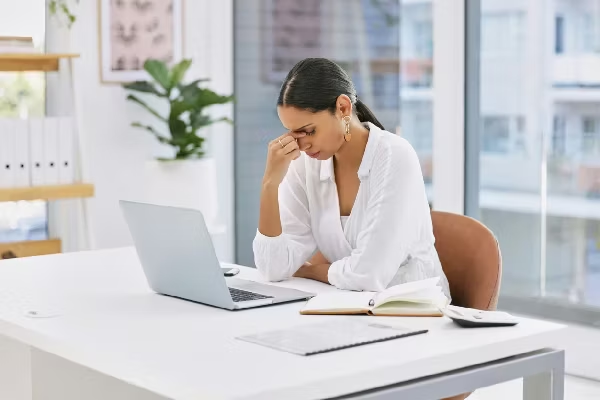I have a nursing colleague who works in the hospital nursery. She loves caring for the babies and their mothers, but going to work used to literally make her sick. That's because she suffers from migraine disease, and the fluorescent lights in the nursery trigger her headaches. Before she was diagnosed and found a treatment program that worked for her, she had to wear sunglasses to do her job.
My friend is one of countless women and men who go to work every day, silently suffering through the debilitating pain of migraine. In many cases, the person may not even know they have migraine disease; they simply think they get bad headaches. But migraine is far more than a bad headache.
A migraine can make a person nauseous, dizzy, extremely sensitive to light and sound and can affect the ears, eyes, nose, mouth, face and brain — in addition to giving the sufferer a severe, throbbing headache that can last for hours or days. The pain can be so severe that it inhibits the person from doing daily activities. This leads to employees missing work or going to work and suffering through the symptoms.
According to the Migraine Research Foundation:
- Nearly one in four U.S. households includes someone with migraine
- 12% of the population — including children — experience migraine
- 85% of people with chronic migraine are women
HealthyWomen is working to raise awareness of this condition and to advocate for workplace policies that support people with migraine and set them up for success.
Triggers
A few months ago, Dr. Rashmi Halker Singh wrote about her experience living with migraine disease for HealthyWomen. Dr. Singh recounted how, during her residency, she had to walk past a coffee cart in the hospital every day, and every day the smell of coffee triggered a migraine attack. Looking back, she said the pain was debilitating, and she had a hard time functioning.
Imagine how different that year would have been for Dr. Singh if the coffee cart was simply moved to another location.
Many things can trigger a migraine the fluorescent lights of a hospital nursery or certain smells. In the workplace, we need to understand what those triggers are and work to ensure that people are being conscientious. For example, in nursing, we're not allowed to wear perfume or any type of fragranced body lotion.
Hormones
Research has found a link between hormones and headaches, including migraine. The hormones estrogen and progesterone, which regulate the menstrual cycle and pregnancy, are believed to affect headache-related chemicals in the brain. So, when estrogen levels drop before menstruation, a woman may be more likely to get a migraine. Conversely, when estrogen levels are consistently high, as during pregnancy, women may see relief from their migraine headaches.
Due to the connection between hormone fluctuation and migraines, it's common for girls to begin to get migraine with the onset of their periods. Women may also see an increase in the frequency or intensity of migraine during perimenopause, and then a leveling off again once they enter menopause.
Chronic migraine
Per the International Headache Society, those who experience 15 or more migraine attacks a month, with at least eight days of having headaches with migraine features for more than three months, experience chronic migraine. Each year, roughly 3% of those who have episodic migraine develop chronic migraine.
Those with chronic migraines have a chronic condition, which could be considered a disability under the Americans with Disabilities Act (ADA). However, not all migraine disease is classified as a disability. That's why it's so important for people who think they may have chronic migraine to keep a journal of their headaches, including triggers, and to speak with their health care provider about treatment options.
Workplace discrimination
According to the Migraine Research Foundation, "healthcare and lost productivity costs associated with migraine are estimated to be as high as $36 billion annually in the U.S." Of course, the cost to the mental health of sufferers is incalculable. This is particularly true for women, who not only suffer from migraine disease disproportionately, but are likely to be discriminated against in the workplace because of the misconception that a migraine is just a headache.
Employers can support women (and men) who suffer from migraine disease by offering flexible hours and remote work options (even after the COVID-19 pandemic subsides) and intermittent leaves of absence.
The good news is that there are many organizations working to raise awareness about migraine disease and many more treatment options than were available just a few years ago.
If you are experiencing headaches that don't go away with over-the-counter medications, speak to your health care provider. We at HealthyWomen want you to know that you're not alone, and you shouldn't have to suffer in silence.
This resource was created with support from Allergan Foundation and Bausch Foundation.
Resources
Association of Migraine Disorders
Patients Rising
National Headache Foundation
American Migraine Foundation
- Self-Care for Migraine Attacks – You Don’t Have to Suffer ›
- Migraine Headaches Are a Family Affair ›
- The Migraine Treatment You Don't—But Should—Know About ›
- Managing the Workspace with Migraine: One Nurse’s Prescription for Managing Her Migraine Attacks ›
- What To Do About Migraine at Work - HealthyWomen ›
- Lo que debes hacer acerca de migrañas en el trabajo - HealthyWomen ›






